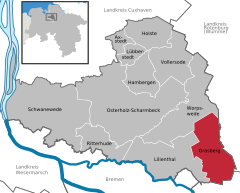Grasberg
| Grasberg | ||
|---|---|---|
|
||
| Coordinates: 53°11′N 8°59′E / 53.183°N 8.983°ECoordinates: 53°11′N 8°59′E / 53.183°N 8.983°E | ||
| Country | Germany | |
| State | Lower Saxony | |
| District | Osterholz | |
| Government | ||
| • Mayor | Marion Schorfmann (CDU) | |
| Area | ||
| • Total | 55.54 km2 (21.44 sq mi) | |
| Elevation | 5 m (16 ft) | |
| Population (2015-12-31) | ||
| • Total | 7,694 | |
| • Density | 140/km2 (360/sq mi) | |
| Time zone | CET/CEST (UTC+1/+2) | |
| Postal codes | 28879 | |
| Dialling codes | 04208 | |
| Vehicle registration | OHZ | |
| Website | www.grasberg.de | |
Grasberg is a municipality in the district of Osterholz, in Lower Saxony, Germany. It is situated approximately 13 km southeast of Osterholz-Scharmbeck, and 20 km northeast of Bremen.
Before the cultivation and colonisation of the area comprising today's Grasberg, the landscape was dominated by moorlands. The area belonged to the Prince-Archbishopric of Bremen, established in 1180. By the Peace of Westphalia the Prince-Archbishopric was transformed into the Duchy of Bremen in 1648, which - together with the Principality of Verden - was first given as a prey for its participation in the Thirty Years' War to be ruled in personal union by the Swedish Crown. These two imperial fiefs to the Swedes are thus colloquially called Bremen-Verden.
After a Danish occupation (1712–1715) the Duchy of Bremen was sold to the House of Hanover, and thus became ruled in personal union with the Electorate of Hanover and the United Kingdom. It was Bremen-Verden's government which commissioned the drainage, cultivation and colonisation of the moorlands, first under the responsibility of Moor Commissioner Jürgen Christian Findorff (1720–1792).
In 1785-89 Findorff prompted - after his own design - the construction of the Lutheran church of today's Grasberg on a sandy grass-covered hill (c. 5 m above sea level), giving the name to Grasberg (literally in English: grass mount), serving as a parish church for 12 newly founded villages in the lower moorlands.
The Lutheran church houses a rare treasury, the only surviving small scale urban pipe organ created by the famous Arp Schnitger, originally commissioned by an orphanage in Hamburg in 1694. In 1789 Grasberg's congregation bought the organ.
...
Wikipedia




